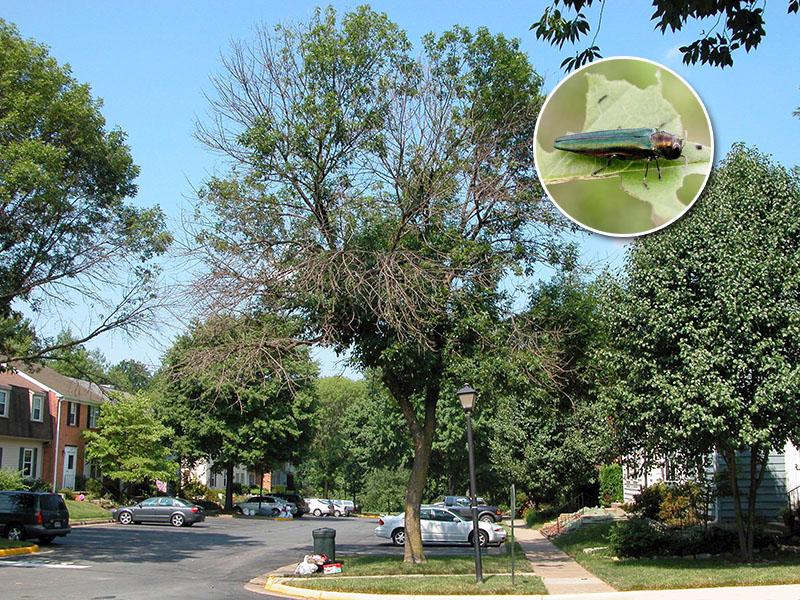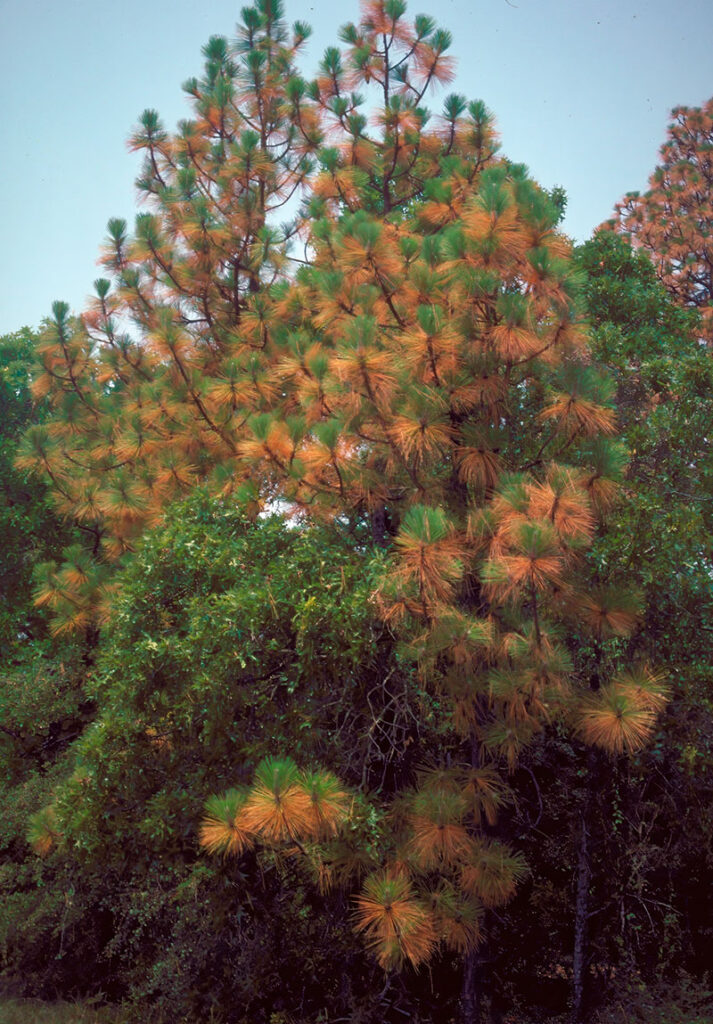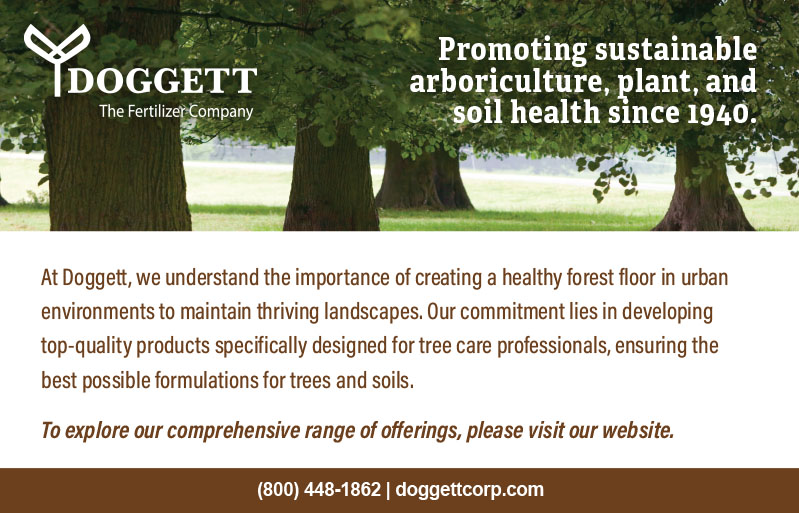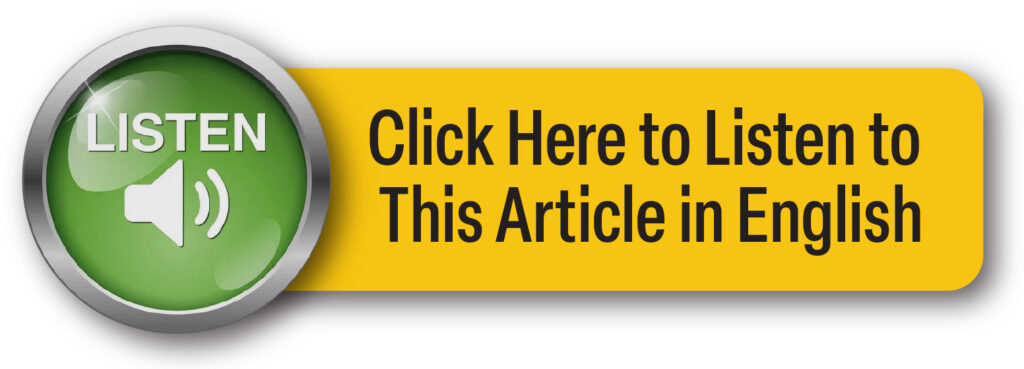Pest Prevention
Fall and winter are ideal times to start protecting trees against spring infestations
Este es nuestro intento de convertir las historias en audio español usando Inteligencia Artificial. Aún así le recomendamos que reconfirme ciertas palabras clave y temas. ArborTIMES no garantiza ni se responsabiliza de la conversión del inglés al español de los relatos.
_
Emerald ash borer, Dutch elm disease, sudden oak death. The mere mention of these insects, fungi, and diseases is likely to keep any arborist up at night. Whether they bore, suck, or chew, these pests can wreak havoc on entire forests and tree communities.

Photo by Eric R. Day, Virginia Polytechnic Institute and State University, Bugwood.org
Inset photo by Debbie Miller, USDA Forest Service, Bugwood.org Inset: An adult Emerald Ash Borer.
In Massachusetts, keeping watch for invasive pests is a full-time job. When the state’s 3.2 million acres of forests enter their dormant season, four foresters take to the sky, hop on boats, and creep on foot to meticulously track the spread of beech leaf disease (likely caused by Litylenchus crenatae, a foliar nematode) and spongy moths (Lymantria dispar).
“They’re out there with their binoculars all winter,” says Nicole Keleher, director of the Massachusetts Department of Conservation and Recreation’s forest health program. “It’s complex, there’s a lot going on.”
After a busy growing season, it might be tempting for tree care companies to take a break as fall and winter approaches. But for those with their eye on the future, they know a new cycle of work is about to begin.
“By the fall you’re worn out. But you have to wake up for a few minutes,” says Chip Doolittle, president of ArborSystems, a provider of injection solutions to treat tree pests. “Just before you take off on that vacation, you need to be planning what you’re going to be doing next year.”

Photo by David Cappaert, Bugwood.org
The need for vigilance
In 2021, more than 5.8 million acres of trees were killed and 5.7 million acres suffered damage from pests and diseases in the United States, according to the U.S. Department of Agriculture.
That same year, a study in the journal Frontiers in Forests and Global Change discovered that forests damaged by insects and disease were reducing the carbon sequestration potential of forests across the country by about 50 million tons of carbon dioxide each year, about 10 million cars’ worth of emissions.

Every tree has its nemesis, generally categorized as arthropods (insects and spiders,) vertebrates (animals,) weeds, pathogens, and nematodes. For the most part, trees have spent hundreds of millions of years evolving a system of checks and balances to stave off attacks from pests.
Yet, introduce a foreign pest to the area or plant a non-native tree and all bets are off. As arborists look toward spring, it’s hard to make predictions on how pests will behave.
“We don’t know what to expect, but it’s coming into our ports right now,” says Rob Gorden, director of urban forestry and business development with ArborJet, Inc., a provider of tree injections and pneumatic soil excavation tools.
He points to the emerald ash borer (Agrilus planipennis), whose larvae feed under the bark of ash trees, disrupting vascular systems and choking off water supplies. Native to Asia, it likely arrived in the United States in wood packing materials in 2002.
“While they may target weaker trees in Asia, here they attack healthy trees,” Gorden says.
Like many pests, the emerald ash borer keeps a low profile, with new infestations avoiding detection for up to three years. After frantically feeding and multiplying in spring, most pests sink into hibernation, a sliver of time that gives arborists the perfect opportunity to shore up defenses and mount a counterattack.
“Fall is an interesting time because there’s not a lot of pest activity going on,” says Mark Ware, an “arborologist” who provides product tech support for Rainbow Ecoscience, which provides treatment products, equipment, and research. “But what I really like about fall is that it’s a great opportunity to alleviate plant stress.”

Giving trees a fighting chance
A healthy tree offers a variety of natural defenses against pests, including structural barriers, such as sap or wax, toxic chemicals, and the attraction of pests’ natural enemies.
However, these barriers can be overcome when a tree is stressed or suffers damage. It can be hard to see this damage when a tree is lush with foliage. So, winter is the perfect time to observe pest infestations when fallen leaves expose a tree’s limb structure.
In protecting trees, an arborist’s work begins with simple observation and tracking to accurately identify what is attacking a tree. Aphids, for example, are often a harbinger of more destructive pests to come.
“Do aphids kill the tree? No,” says Bill Stringfellow, managing director at Quest Products, LLC, which provides pesticide and fertilizer products. “But what they do is suck the juices out of the leaves and get honeydew around the ground. And that can attract other pests that the tree can’t protect against.”

Photo by Albert (Bud) Mayfield, USDA Forest Service, Bugwood.org
Arborists use preventive measures, such as pruning, mulch, soil amendments, and proper watering, to support plant health. This work can continue with the introduction of friendly insects, quarantine to limit the spread of diseases, and pesticides to directly counteract pests.
When treating trees against pests, the biggest mistake an arborist can make is “not getting out there early enough,” says Stringfellow. He points to apple scab (Venturia inaequalis), a fungus that appears in early spring, with full effects seen in June or July. “By that point, it’s too late to do anything. You treat in the fall to reduce the amount of pathogens in the spring.”
Pests and diseases can leave a wide range of clues and footprints to indicate their presence. Signs can include chewed, distorted, or stippled foliage, white spots or masses, holes or boring tracks in bark, sticky substances, and leaf spots.
Tree care professionals may have good intentions when it comes to protecting trees, but it can take a trained eye and years of experience to know how and when a pest has invaded.
“Most people aren’t trained to look at the subtle symptoms,” says Rafael “Andy” Vega, chief science officer for J.J. Mauget Co., which provides tree injection supplies and equipment. “Getting a team of specialists who are trained in monitoring for insects and diseases is going to be more critical.”
Weather indicators
Climate change has been creating unpredictable weather events that are challenging a tree’s ability to defend itself.
“There’s no denying that weather patterns have gotten strange over the last five to 10 years,” says Ware. “Because of that, we’re seeing a significant increase in environment stresses, which makes trees a lot more susceptible to pests.”
Trees play a significant role in counteracting the effects of climate change, such as capturing carbon dioxide in the atmosphere, providing shade, and reducing wind. However, they can easily be overwhelmed by extreme weather events, especially with the one-two punch of heat and water scarcity.

Photo by Robert L. Anderson, USDA Forest Service, Bugwood.org
“Sometimes, we get a new invasive species that are well adapted to our climate. Sometimes, we see natives that are dealing with conditions that are favorable and allow for pests,” says Keleher. “If you have a site where trees are really stressed out, their defense can go down and they can be affected.”
Arborists have a number of tools to help anticipate how pests will behave in the spring, including soil temperature, dew point, and growing degree days (GDD.) First identified in 1735, GDD is a weather-based indicator that measures heat accumulation to indicate plant and pest development.

Graphic courtesy of the EPA
The rise in temperature one year often heralds the early arrival of spring — and pests — the following year.
“Pests are emerging at an earlier time and over-wintering at a later time,” says Vega. “This adds a generation or two to their life cycles.”
With each year different from the last, it can be hard to make predictions.
“Is anyone a prophet or a forecaster?” asks Doolittle. “What to expect in the spring is determined by all the vagaries of the year that you’re in.”
Doolittle’s approach to pests is simple: keep an accurate record of what happens, plan for the worst, and take care of problems immediately. “There’s something different every year,” he says.
Armed with this knowledge, many tree care professionals can avoid the use of pesticides or tree removal to control pests.
“If we can do cultural practices that don’t require pesticides, then we’re already ahead in the spring,” says Ware. “There are some [tree care] companies that have no interest and don’t learn it, and they just cut down trees.”
Pesticides and fertilizers
Pesticides have come a long way from when they were first introduced in the 1930s and 1940s. Treatment used to involve spraying and coating entire 30- to 40-foot trees with gallons of pesticides. Not only was this expensive, but even a gentle breeze could easily blow products to areas where they didn’t belong.
Now, pesticides and fertilizers can be injected or implanted directly into the tree and soil, making them targeted and cost-effective. These work by taking advantage of a tree’s water transport system to bring the chemicals to the leaves, shoots, and roots where it’s needed.

“We use the tree’s biology to take care of that,” says Vega. “When we inject trees down at the base, we can move a chemical from the base of the tree up to 60 to 80 feet.”
The trick, of course, is making sure the pesticide is available to the tree when pests arrive and begin to proliferate.
“The warmer the climate, the more frequent the lifecycle can occur for pests,” says Gorden. “These products need to last long enough to give you the protection that’s needed. If it’s not there for the second or third generation, what have you really accomplished?”
Pesticide manufacturers continue to conduct tons of research to anticipate pest patterns and provide safer and more effective products to customers.
“The technology is constantly improving,” says Ware. “Before, arborists might use 40 to 50 gallons of product to treat a single tree, which increases the potential for chemical trespass and drip concerns. Now, we have products that you can apply a millimeter of and it can last up to two years.”
The need for education
Unfortunately for arborists, by the time customers call to ask for help with a tree, it’s usually too late. As Doolittle points out, “You don’t walk into your doctor and say, ‘Man, I’m feeling great, what’s wrong with me?’”
To get ahead of pests, tree care companies can spend time cultivating awareness among their customers throughout the year, but especially in winter.
“Setting expectations is critical,” says Ware. “It’s easy to lose sight or track of things during the growing season. Winter is a good opportunity to get feedback and reach out.”
Customers may be unaware that their own actions may be threatening the health of their trees. Keleher points to summer boats parked next to a tree all winter as an example, compacting the soil, bumping into trees, and inadvertently creating pathways for pests to get in.
“Winter can be really rough for trees,” Keleher says. “For me, it’s about keeping them safe and not allowing intentional damage.”
When trees do suffer, a customer’s desire for aesthetics and convenience all too often drives the premature decision to cut down trees, something many feel the tree care industry isn’t doing enough to avoid.
“One of the things I’ve noticed when I go to conferences and meetings is that there seems to be a void in plant health care,” Vega says. “There’s a lot of people taking down trees and less of them taking care of the trees to keep them there.”

Image courtesy of ISA
Often, arborists have to balance the needs of the tree against the desires of the customers. Proper client education starts with encouraging the use of natives and knowing where and how to plant them. It continues with maintaining a detailed plant inventory to give credence to an arborist’s recommendations.
“Arborists have to go back and review what has happened this year to their trees,” says Doolittle. “This may be the time to think about fertilizing plants, not for growth, but for some of the surrounding plants that may’ve gotten stressed, as this can affect their tree neighbors.”
When it comes to using pesticides, Gorden points out that “the barriers of entry to this business are not very high. You can go from being a landscaper and planting trees to spraying stuff quite easily.”
Regulations governing the use of pesticides are set by the U.S. Environmental Protection Agency but can still differ from state to state. Ultimately, customers rely on arborists to guide them. This is where training and education offered by organizations such as the International Society of Arboriculture can come in handy.
“Getting a company certified is a way to gain the public’s trust,” says Gorden. “You have a responsibility to protect that, and you have to decide as a company how to balance that. Otherwise, a tree that takes 60 years to grow will not be there for you to sit under.”


